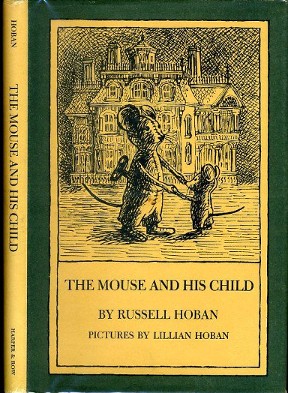The Mouse and his Child (Novel, 1967)

The Mouse and His Child is the story of two clockwork mice, a father and son. When the key in the father's back is wound, he dances in a circle, swinging his son up and down. They begin their existence in the warmth of a toy shop at Christmastime, surrounded by fellow windup toys; all the mouse child wants is for the lady elephant (who rather puts on airs) to be his mother, the seal who balances a ball on her nose to be his sister, and for them all to live in the elegant doll house on the counter. Alas, there is a long and difficult journey between the mice and any such hope of happiness. Soon they are sold to a family, and for several years are only brought out at Christmas. On one such night, the mouse child is overcome with longing for the elephant and the doll house, and, breaking the all-important "rules of clockwork," he begins to cry. The family cat is so startled she knocks a vase onto the toy mice, and soon they're in the garbage can, smashed out of shape.
But their story is only just beginning. A passing tramp finds them in the garbage can, repairs them, and sets them on their way with the command, "Be tramps." Soon they've fallen into the murderous clutches of Manny Rat, a sleazy, tyrannical crook who uses wind-up toys for slave labor and doesn't hesitate to smash the ones who get out of line. The mice escape him with the intervention of a snake-oil-peddling, fortune-telling frog (conveniently named "Frog"), who startles Manny Rat (and himself) by uttering a terrible prophecy regarding the linked fates of the mice and the rat: "A dog shall rise; a rat shall fall."
After a brief dust-up involving some militant shrews, the mice are off, with Manny Rat, vowing vengeance on them for making him look like a fool, in hot pursuit. Their travels will take them through the air and down to the bottom of the pond, as they search for the elephant, the seal, and the doll house, assembling a ragtag family to help them fight for their lives and their chance at happiness. Along the way they encounter the professorial Muskrat, who promises to help them become self-winding; trade philosophy with C. Serpentina, the snapping turtle thinker, scholar, and playwright who lives at the bottom of the pond; and, in a twist straight out of Nicholas Nickleby, fall in with a traveling theater company called The Caws of Art. (It consists of two crows, a parrot and a rabbit.)
The Caws of Art are performing an experimental play called The Last Visible Dog, written by C. Serpentina, inspired by the image on the label of Bonzo Dog Food cans. The dog on the label is holding a can of dog food, on the label of which there is a smaller dog, holding a smaller can on which there is an even smaller dog, and on and on as far as the eye can see. The recurring concept of "The Last Visible Dog" becomes an eloquent metaphor for patience, persistence and determination, as the mouse and his child find that in order to realize their dreams of domestic contentment they must remain focused on a goal that seems further away than the eye can see, and travel farther than they ever dreamed.
Review quotes:
"A rare treat." Booklist
"A rich, disturbing, very touching book." Kirkus Reviews
"The sophisticated humor, symoblism, and fantasy will appeal to Thurber, Tolkien, and E. B. White Readers." Library Journal
"Both comforting and devastating, this tale of two discarded toy mice by the Riddley Walker author is a profound little book – the equal, in some ways, to the Alice books" - Stuart Kelly, The Guardian
"Links to buy online" do not imply endorsement of the sellers. Users of this site are advised to compare prices before buying.
